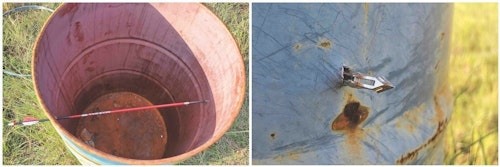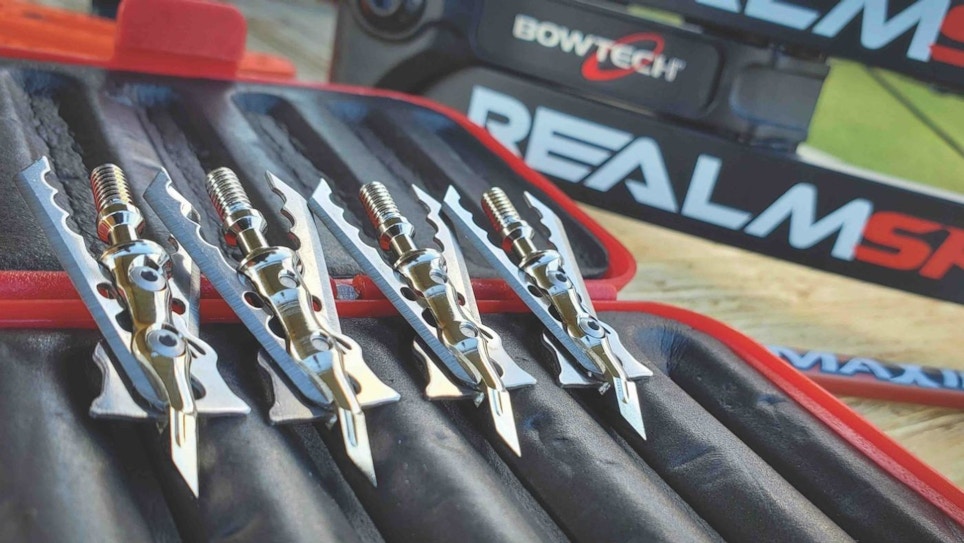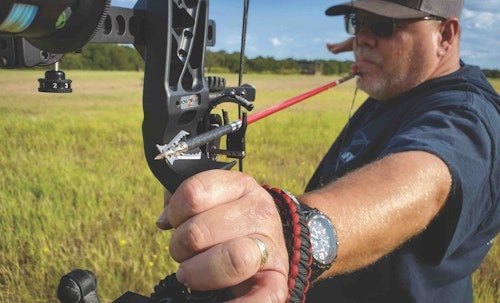Rage Broadheads burst onto the bowhunting scene in 2005 with a rear-deploying mechanical blade system boasting a 2-inch cutting diameter and a heavily marketed, patented slip-cam system. Not long after, “Rage in the cage” became a something of a household moniker. For years now, Rage has been under the FeraDyne umbrella and appears to have benefited greatly from the corporation’s deeper pockets, especially with respect to research, development and continued marketing efforts.
With FeraDyne at the helm, Rage Broadhead offerings have morphed from the original slip-cam and O-ring two- and three-blade systems most seasoned bowhunters recognize, to a wealth of dramatically improved heads and advanced locking-deploying functionality — yes, still premised on the Rage’s original slip-cam design. Today, Rage’s lineup comprises 17 two-, three- and four-blade broadhead models. The most popular seems to be Rage’s latest, greatest, Hypodermic NC heads — great news since this is the model I’ve been tasked with testing.
Looking Sharp
Rage made a significant R&D leap with the Hypodermic, incorporating Rage’s large cutting diameter with a needle-type hybrid tip and certainly, at least for the Hypodermic +P and Hypodermic Crossbow heads, a narrower ferrule designed for improved accuracy. The Hypodermic still utilized Rage’s shock collar system. However, the 2019 unveiling of the Hypodermic NC, also introduced the tip’s No Collar design. That’s right. Rage’s new Hypodermic NC eliminated the need for shock collars or O-rings, as well as any fear that added components stand to compromise success in the field — seriously, less to worry about is always a win in bowhunting.
Rounding out the Hypodermic NC’s design are the two large, skeletonized blades constructed of ridiculously sharp, .035-inch, stainless-steel blades. Deployed, the blades deliver the same gaping 2-inch cutting diameter bowhunters have come to expect from Rage. In shooting position, the blades are locked into the ferrule with a truly reliable-feeling positive containment system provided by an internal spring-clip system that is held inside the ferrule by one of the two fasteners. The other fastener anchors the Hypodermic NC’s blades on their slip-cam axis for reliable deployment. Both blades feature front shoulders at roughly 90-degree angles to the ferrule. Upon impact, the force of the target or game animal on the blade shoulders force the blades down on the slip-cam and out to their fully extended cutting diameter. Rage Hypodermic NC’s rear-deploying system ensures a large wound channel, beginning at the entrance and, given a pass-through, a gaping exit wound purposed in significant bloodletting, quick kills and short track jobs.
For me, broadhead testing is simple — how do they group and what can I push them through? I’m a bit of a brute here. Pushing broadheads through bone or a big boar’s tough shield takes energy, and more importantly, momentum. That said, meat and bone testing is good, but for me, blowing through half-inch plywood and rolled steel is even better. After all, is there any reason to believe that a broadhead capable of pushing through these materials won’t get through meat, bone and vitals? Besides, shooting through hardcore materials makes for more interesting results, right?

The Setup
To test Rage’s Hypodermic NC broadheads, I employed my current go-to bowhunting setup: a Bowtech Realm SR-6 compound bow with a draw weight of 70 pounds and 27-inch draw length, QAD Ultra Rest MXT arrow rest, Spot-Hogg Hogg Father bowsight and Carbon Express Maxima Red 350 arrows with 2-inch Blazer vanes.
For inquiring minds, my speed, energy and momentum weren’t legendary by any stretch, but pretty respectable considering my draw length, quite a bit of weight on my string, as well as the overall weight of my arrow setup — 392.2 grains, including the 100-grain Hypodermic NC broadheads that actually average 101.4 grains. With my stubby 27-inch draw length, I’m running 275 fps. As final notes on my setup, kinetic energy was just over 66 and momentum at .48 slug-fps/2.1 Ns. While I might like a bit more punch for a big game animal such as elk — and getting there wouldn’t take much at all — it makes the results from my brutal broadhead testing that much more impressive. More on that in a bit.
Testing, Testing
For initial testing, I stayed home and turned to my new GlenDel Buck target and Caldwell G2 chronograph. After gathering speed data, I focused on accuracy. I shot with field points, followed by the Rage Hypodermic NCs. With the latter, my best group was impressive — sub 1-inch at 20 yards. For the remainder of my testing I needed a little more room and more extreme surfaces than a GlenDel buck.
I dropped into my hometown archery range, Fort Grard, in Weatherford, Texas. With Fort Grard’s insanely robust array of indoor and outdoor targets, it was the perfect place to push the Rage Hypodermic NC Broadheads to their max. I began indoors, again at 20 yards and managed another 1-inch group. Soon after, I pushed indoor, shooting out to 40 yards from an elevated platform. My best indoor grouping at 40 yards was right at 3 inches. Moving outside to another 40-yard target, my best grouping mirrored my indoor performance — a 3-inch group at 40, followed by a 5-inch group at 60 yards. I did not move beyond 60 yards because my personal commitment, at least with respect to the vast majority of my own hunting, keeps me taking shots no farther than 40 yards. Besides, with arrow flight and grouping data collected, it was time to move onto more aggressive testing — 18-gauge steel and half-inch plywood.
Brute Force and Clean Cuts
Fort Grard is literally covered with 27 acres of 3-D targets, even some arrow-shattering steel silhouettes with thread-the-needle sized holes — not for the faint of heart or budget-conscious bowhunter — don’t ask me how I know. In a place like that there is no shortage of extreme testing opportunities to be had — including the half-inch plywood I was after and a 55-gallon, 18-gauge steel drum. Of course, it helps when a good friend like long-range archer and Fort Grard apprentice archery tech, Justin Lowes, knows exactly where to find them — along with the keys to range’s UTV.
First up, I took aim at the plywood resting against a target frame 20 yards away. Upon release, the arrow raced into and completely through the plywood, skipped off the ground, rose again and ultimately, hit a target stand leg roughly 20 yards beyond the plywood it had just blown through.
The result was pretty impressive: a Hypodermic NC cut a 2-inch swath clear through the half-inch-thick plywood. The cut was significant through the board, but when I recovered the arrow, only one blade remained. It was lost going through the plywood or when it hit the target stand leg in the background. Either way, the board was left with quite a respectable gash, and the remaining blade showed no visible sign of structural damage — it still retracted back into the ferrule properly. Down a broadhead, it was time to find some steel.
Up next, the steel drum. Justin drove the barrel over to an open spot of ground, stood it up and we laser-ranged it at 20 yards. Like before, I drew, aimed, breathed, relaxed and squeezed. Again, my arrow blazed its way to the drum. In an instant, the heavy ringing thud of my arrow connecting with steel reported back. No pass-through, but the Range Hypodermic NC’s performance was no less impressive; in fact, it was more so. What didn’t appear to be a pass-through actually was, at least to the extent that the arrow most certainly fully penetrated through both barrel walls! The first steel wall was left with a cut diameter of at least 1-inch. The second steel wall was more of a bullet hole with only the ferrule pushing through. The blades were broken off sometime before or during the impact on the interior of the second wall. While I did have a clearly symmetrical blade-cut through the first wall, pieces of the blades laid in the bottom of the barrel.
Perhaps even more impressive was the Hypodermic NCs hybrid tip. Upon inspection, I found no noticeable damage — the tip did not appear rolled and it was still quite sharp.

Takeaways
Rage is in a good place and the Hypodermic NC is a testament to that. Rage has essentially reaffirmed to me that precisely accurate, razor-sharp, high-quality mechanical broadheads do have a place in the quivers of bowhunters going after big bucks, bigger boars and big-time memories.







